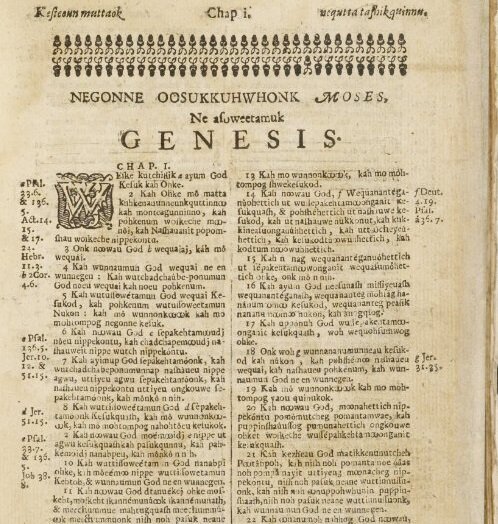
Nathaniel Hawthorne mentioned Rev. John Eliot in three of his novels, including The Scarlet Letter.
Rev. John Eliot in American Literature
Rev. John Eliot (1604-1690) was a respected figure in the 17th century among the religious and political leaders of the Massachusetts Bay Colony and church and government notables in England. Eliot was actively engaged in the colonial Puritans' social concerns and missionary work. He had essential ties with benefactors and Puritan leaders in England.
The Roxbury minister was an essential and unwavering supporter of the Algonquian Indian leaders, preachers, and teachers who established 14 “Praying Indian” towns, beginning with Natick in 1651. Eliot was significantly involved in supporting and developing the “Praying Indian” towns for the rest of his life. One of America’s iconic novelists, Nathaniel Hawthorne (1804-1864), acknowledged his high-profile roles in the emerging Indian/colonist relationships three times in 19th-century literature.
The Scarlet Letter
The Puritan minister is mentioned twice in Hawthorne’s classic romantic fiction novel, The Scarlet Letter. It was published in 1850, almost two centuries after Natick was established. Two principal characters in The Scarlet Letter are Hester Prynne, who is forced to wear a scarlet “A” in public because her child has no acknowledged father, and Rev. Arthur Dimmesdale, the respected town minister who is the unsuspected father. Hawthorne references Eliot to help establish Dimmesdale’s genuinely reflective, religious state of mind.
In Chapter 16, when Hester seeks to talk with Dimmesdale, there is a reference to the cleric’s brief journey “…to visit the Apostle Eliot, among his Indian converts.” In Chapter 20, during his return, Dimmesdale explains that his intention had been “…to greet that pious friend of mine, the Apostle Eliot, and rejoice with him over the many precious souls he hath won from heathendom!” Further, in a troubled conversation, Roger Chillingworth (Hester’s estranged and vengeful husband) says, “Welcome home, reverend Sir…And how found you that godly man, the Apostle Eliot?” Dimmesdale responds: “My journey, and the sight of the holy Apostle yonder, and the free air which I have breathed, have done me good, after so long confinement in my study.”
Title page from The whole history of grandfather's chair; or, True stories from New England history, 1620-1803, The Internet Archive
The Whole History of Grandfather’s Chair
In a much different literary milieu, Hawthorne includes many references to the Puritan missionary in a highly detailed child’s history of New England, The Whole History of Grandfather’s Chair (1840).
From the author’s preface: “…while ostensibly relating the adventures of a chair, [I have] endeavored to keep a distinct and unbroken thread of authentic history. The chair is made to pass from one to another of those personages whom [I] thought it most desirable for the young reader to have vivid and familiar ideas…”
In the story, Eliot, as one of the “personages,” uses the fictional “grandfather’s chair” when he is working with James the Printer and other Indians to create an Algonquian language bible and passes the chair on to Gov. Simon Bradstreet in 1689.
Hawthorne’s “grandfather” says: “I have sometimes doubted whether there was more than a single man among our forefathers, who realized that an Indian possesses a mind, heart, and an immortal soul. That single man was John Eliot…He looked upon them as his brethren…”
Nathaniel Hawthorne portrait, Mathew Brady c. 1860s, Library of Congress
The Blithedale Romance
Finally, Hawthorne casually cites Eliot in his third major work of fiction, The Blithedale Romance (1852). This critically respected example of Romantic Era fiction has been described as “the darkest of Hawthorne’s novels.” The setting is “Blithedale,” a fictional utopian farm commune that recalls Brook Farm, an experimental, Transcendentalist farming community (1841-1847) in West Roxbury, MA, where Hawthorne lived and worked for a short time in 1841 as a founding member.
In Chapter XIV, Hawthorne invokes the name of “the venerable Apostle Eliot” in describing “Eliot’s Pulpit” rock in a woodland clearing frequented by principal characters in the story. The lofty rock is a platform from which Eliot “had preached, two centuries ago, to an Indian auditory. The old pine forest, through which the Apostle’s voice was wont to sound…” The “pulpit” is an isolated, solemnized refuge and is the scene of several interpersonal subplots involving the main characters.
Selected sources and additional reading:
Natick Historical Society collections.
Hawthorne, Nathaniel. The Scarlet Letter (1850), The Whole History of Grandfather’s Chair (1840), The Blithedale Romance (1852).
HathiTrust. “Grandfather’s chair, and Biographical stories, by Nathaniel Hawthorne; with Illustrations.” Accessed December 1, 2019. https://babel.hathitrust.org/cgi/pt?id=hvd.32044097040505&view=1up&seq=13



